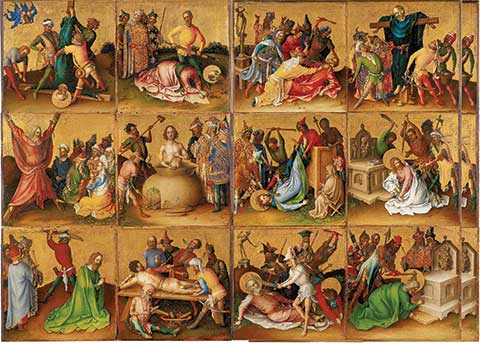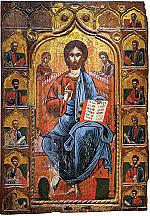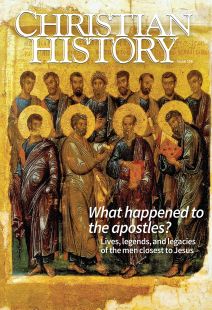Did you know? What Happened to the Apostles?

[ABOVE: Stefan Lochner, The Martyrdom of the Apostles, 1435—Städel Museum / Public domain, Wikimedia]
LEGENDARY ENDS
Clement of Alexandria (150–c. 211) repeated a story that James’s guard was so impressed by the apostle’s testimony that he confessed his own faith in Christ. The guard asked forgiveness from James, who replied, “Peace be with you” and kissed him. Thus they were beheaded together.
Bartholomew’s supposed martyrdoms were varied: he was crucified, drowned, beaten, beheaded, and flayed. But the image of Bartholomew being flayed most captured the imagination of Christian artists, who often portrayed him holding his own skin. For examples see the statue by Pierre Le Gros the Younger (1666–1719) in St. John Lateran Basilica and Michelangelo’s Last Judgment in the Sistine Chapel, both in Rome. Michelangelo (1475–1564) allegedly created the face on Bartholomew’s skin as a self-portrait.
A late legend relates that when Paul was beheaded, his head bounced three times and a fountain miraculously sprang up at each place where it touched the ground. Today the Church of St. Paul of Three Fountains, located on the grounds of Tre Fontane Abbey in Italy, marks the spot of Paul’s alleged martyrdom.
FANTASTIC PHILIP AND OTHER MYTHS
In the Acts of Philip, a leopard approaches Philip to confess his wounding of a kid goat, who wept and warned his predator of the coming messengers of God. Philip heals the goat; the leopard becomes a vegetarian; both animals raise their paws in prayer; and ultimately they request Christian sacraments and receive baptism and Holy Communion from Philip.
Philip’s final acts took place in Hierapolis in Asia, known as the city of snakes, which residents worshiped. At the entrance to the city were two dragons and seven snakes guarding the city gates. The snakes prostrated themselves before the apostles, and Philip destroyed the dragons with rays from his eyes. For this reason Philip often is shown with his foot on the head of a serpent; for example he is depicted this way in the statue of him sculpted by Giuseppe Mazzuoli (1644–1725) in St. John Lateran Basilica in Rome.
In the fourth century, Bishop Regulus of Patras learned from an angel that Emperor Constantius II (317–361) intended to invade Achaia and confiscate Andrew’s remains and move them to Constantinople. Obeying the angel’s instructions, Regulus removed several relics from Andrew’s sarcophagus and then headed in a westward direction, ultimately landing in Scotland, where he founded St. Andrews Church.
WHAT'S IN A NAME?
The word “apostle” comes from the Greek apostolos, which means “one who is sent forth” or “messenger.”
In the Gospels the apostle Matthew is also named Levi. Possibly Levi was his birth name, indicating his association with the tribe of Levites. When Levi got up from his tax-collecting booth, left everything, and followed Jesus, he received something very special for his sacrifice: salvation and a new name. Matthew means “gift of God” in Hebrew or “faithful” in Aramaic.
Twice in the Gospel of John, the author states that Thomas was also “called Didymus” (John 11:16, 21:2), meaning he was a twin. In fact Thomas is the Aramaic word for “twin,” while Didymus is the Greek one. But who was Thomas’s twin? The Bible provides no clues, but second-century heretical writings, purporting to be written by Thomas, claimed that his twin was Jesus himself.
When James the son of Alphaeus, often surnamed “the Less,” appears in the apocryphal acts, his story is conflated with that of James the brother of Jesus, also known as James the Just. According to various legends, both were stoned and beaten to death by the Jews. The conflation of James the son of Alphaeus with James the brother of Jesus was often depicted in artwork. For example in St. John Lateran Basilica, the statue of the apostle identified as James the Less is shown with a book, representing the book of James, and a fuller’s club symbolizing the kind of death suffered by James the Just.
APOSTOLIC INSPIRATION
The air battle between Simon Peter and Simon Magus found in the Acts of Peter and Paul (see p. 23) was the inspiration for the helicopter flight of the Camerlengo in Dan Brown’s Angels & Demons (2000).
In 832 the Scottish Picts were at war with the Angles of England. King Óengus (or Angus, d. 834) heard the apostle Andrew’s voice from heaven, who promised victory and foretold the sign of the cross in the sky as proof. On the day of battle, the king saw rays of light forming the X-shaped cross in the blue sky, and his soldiers advanced with the battle cry: “St. Andrew, our patron, be our guide!” From the ninth century, Andrew has been the patron saint of Scotland, and the Scottish flag depicts St. Andrew’s white cross on a sky-blue field. CH
By the editors
[Christian History originally published this article in Christian History Issue #156 in 2025]
Next articles
Letters: What Happened to the Apostles?
Readers respond to Christian History
our readers and the editorsEditor's Note: What Happened to the Apostles?
God reveals himself to us in a true story
Kaylena RadcliffSupport us
Christian History Institute (CHI) is a non-profit Pennsylvania corporation founded in 1982. Your donations support the continuation of this ministry
Donate







